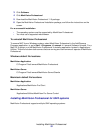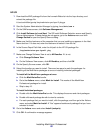
Installing MarkVision Professional
23
c When a message appears telling you the installation was successful, type q to quit.
Note: You must install all the packages in the same location.
5 Type the following on the command line and answer any questions that appear:
/opt/lexmark/setup.mvjserver
Unix general file locations
MarkVision Application
/usr/mvp/bin (executable files)
/usr/mvp/etc (configurable files)
/usr/mvp/lib (archive/library (JAR) files)
MarkVision Server
/usr/mv_pro/bin (executable files)
/usr/mv_pro/etc (configurable files)
/usr/mv_pro/lib (archive/library (JAR) files)
Setting up the MarkVision Professional UNIX Server
Once the MarkVision Professional package is installed on a system, a setup script must run to
complete the installation process. This script is installed at:
<install-dir>/setup.mjserver
The MarkVision Server must be run as a standard system daemon. It collects information about
network attached devices, such as printers and print servers. For security reasons, this daemon
must be run as a normal user with no special privileges. Therefore, we recommend using an existing
user ID or to create a special user ID for this daemon to run as.
The default user ID is user nobody. Most modern UNIX systems ship with this ID pre-installed. If you
want to change it and use a different ID (for example markvision), create the user ID before running
the setup script.
The setup script checks if the MarkVision Server is currently running, and if so will exit, prompting the
user to stop the server using the appropriate command. If the server is not running, it prompts for the
user ID and verifies its validity. Once the user ID is verified, the MarkVision Server starts.
The following shell scripts are used during the MarkVision Server setup and startup process:
• /usr/mv_pro/bin/findJava
• /usr/mv_pro/bin/MvService
• /usr/mv_pro/bin/MvWebService


















